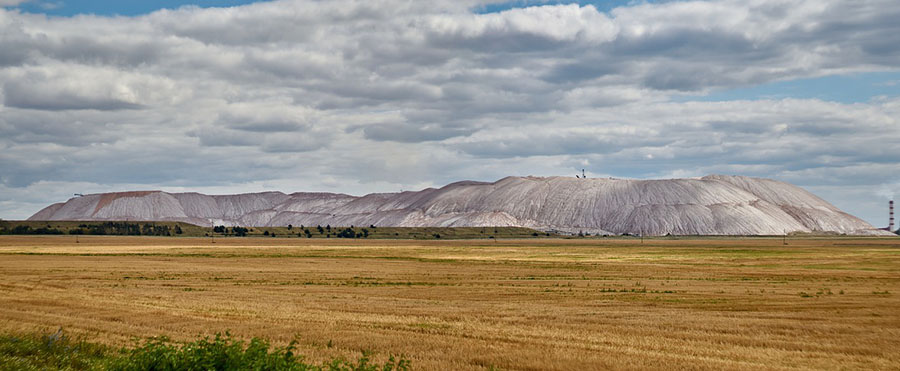The Energy Report: Fadi, the International Fertilizer Industry Association is reporting that the fertilizer market is on the mend, with demand for potash rising 3.7% per year. Today, U.S. potash prices are at about $575 per metric ton (mt), compared with $380/mt last year. What caused the upswing?
Fadi Benjamin: Let's look at what caused the potash crash: Back in 2008–2009, potash prices had risen to almost $1,000/mt, driven by Chinese demand. Crop prices were relatively low at $3.50 corn, $10.25 soy and $4.44 wheat. Farmers around the world retaliated as they could not justify the economics of these high potash prices and low crop prices. Many farmers, particularly in North America, took a "potash holiday." They stopped applying the mineral to cropland for a couple of years. The holiday was possible because crops do not consume all of the fertilizer immediately, and the remainder stays in the soil as a reserve. But now, all around the globe, the potash content in soils is too low. The demand for potash has returned, and crop prices have significantly increased. We are now in a world of $7.90 spot corn prices, $16.65 spot soy and $8.89 spot wheat. It may take two to three years of aggressive potash application for North American soils to reach 2008 soil levels.
TER: Will the predicted slowdown of growth in China and other developing countries impact the outlook for potash?
FB: Slowdown or not, people need to eat. Population is on the rise in developing countries, including China and India. There is a push to grow more crops, to utilize more of the arable land, to improve yields and to raise cattle for meat. Agriculture requires potash.
TER: Which countries and regions are the largest potash consumers, and which are the largest producers? Is there a regional or global synergy between networks of production and consumption?
FB: Canada and Russia are the two largest potash producers. India, China, Brazil and the United States are the largest consumers. There are synergies in the form of two marketing organizations. One, Canpotex, represents North American producers, and the other, Belarusian Potash Co., represents Russian producers. Russia and Canada are the gorillas in the potash cage. They ship potash around the globe, especially to China, India and Brazil, the areas of greatest need.
TER: Saskatchewan holds about 40% of the world's known potash reserves. Should investors look first to Canada for potash production? Which countries are delivering the most bang for the potash investor's buck?
FB: Junior potash miners are quite active in Africa, which is rich in resource commodities. Companies looking for potash in eastern Africa, specifically Ethiopia, include Allana Potash Corp. (AAA:TSX; ALLRF:OTCQX) and Ethiopian Potash Corp. (FED:TSX.V; FED.WT:TSX.V). Companies exploring for potash in western Africa include Elemental Minerals Ltd. (ELM:TSX; ELM:ASX) and MagIndustries Corp. (MAA:TSX). There are a number of explorers in Brazil, including Rio Verde Minerals Development Corp. (RVD:TSX) and Verde Potash (NPK:TSX). But even in highly developed Saskatchewan investors will find a spectrum of companies, from early-stage developers to those that are fairly advanced and in search of financing to build a mine.
TER: Do you have any names in that space?
FB: Western Potash Corp. (WPX:TSX.V) is the most advanced junior potash company in Saskatchewan. Before Western Potash even had a feasibility study of its Milestone project in hand, it had pushed the bar high enough to attract the interest of a Chinese strategic investor, China BlueChemical Ltd. (CBC:HK:3983).
TER: Your firm, Northern Securities, recently lowered the target price on Western Potash from CA$3.30 to CA$2.30. Why? Are you still bullish on the company?
FB: China Blue withdrew at the last minute, so we lowered the target price. Western Potash had been working with China Blue as a potential partner for at least a year. China Blue did six months of research and due diligence. For reasons that have not been disclosed to Western Potash's management, the parent company of China Blue did not approve the deal. But we know the Chinese did not find an issue with the project itself, or the negotiations would not have gone so far.
TER: Western Potash recently signed a deal to purchase city wastewater for use at Milestone.
FB: That is one reason we are bullish on Western. First and foremost, Milestone is an excellent deposit. Now, low-cost water for solution mining is available as well, through Western Potash's agreement with the city of Regina. The Milestone grades are conducive for low operating costs, and Western Potash has access to low-cost natural gas from Canadian shale gas producers. From a logistical standpoint, Western Potash is nicely connected to rail infrastructure and to ports in Vancouver.
TER: You mentioned Elemental Minerals, which is developing a project in the Republic of Congo. What is the news on that front?
FB: Elemental Minerals is a world-class deposit and our top pick from a project standpoint. In the Congo, Elemental Minerals has discovered the Hangingwall Seam, which contains a potash deposit of the highest grade—almost 50% potassium chloride. It is also a very shallow and scalable deposit. The potash horizons are at 260 meters below surface with a resource size of over 1 billion mt. And due to the low cost of natural gas in the Congo, the project has a low capital expenditure (capex). The existing infrastructure of ports and roads in the Congo is a key advantage for Elemental Minerals, and the company has a logistical advantage with easy access to ocean freighting to Brazil, one of the fastest-growing agricultural markets in the world. Brazil's demand for potash is growing annually at a rate of nearly 4%.
TER: The Hangingwall Seam is sylvinite-bearing. Can you talk about how sylvinite and carnallite affect potash grades?
FB: Not all potash is the same. Two types of minerals produce the chemical compound known as potash: Sylvinite is a mixture of potassium chloride and salt. Carnallite is a potassium magnesium chloride. Carnallite is, at best, considered an impurity. It tends to dissolve in water a lot more easily than sylvinite, but it takes energy and time to break the magnesium element out of the brine. Potash producers generally seek sylvinite and avoid carnallite. Carnallite is only sought out for mining in countries where there is no sylvinite.
TER: What kind of potash is being mined in Ethiopia, and what are the prospects for junior miners there?
FB: Allana Potash and Ethiopian Potash are looking for sylvinite. However, their sylvinite layers sit on top of carnallite, so solution mining in these deposits brings along the carnallite, too. One cannot selectively mine for the sylvinite in these seams. Producers have to liberate the potassium chloride from the brine mixture.
Furthermore, Ethiopia-based deposits lack infrastructure support. They sit in a desert far from roads and rail lines, and water is difficult to come by. Allana Potash is drilling wells to find water. Juniors in Saskatchewan and the Congo are not exposed to the same lack-of-water risk.
Allana Potash stands out from the pack in Ethiopia; the company has the better position. Recently, Ethiopian Potash has tried to restructure and reorganize itself. In addition, BHP Billiton Ltd. (BHP:NYSE; BHPLF:OTCPK) has announced that it is not conducting any more exploration at its Ethiopian potash project. This exit brings a bit of uncertainty to the potash zone in eastern Africa.
TER: BHP Billiton has been buying up junior potash producers. Is that good or bad for investors in the junior space?
FB: BHP has been buying juniors since 2007, including Anglo Potash Ltd. and Athabasca Potash Inc. Those were purchases of land more than anything else; no feasibility studies or well-defined projects. The purchases allowed BHP to put forward a plan for its Jansen project, which is one of the world's largest potash mines, in Saskatchewan. The buying spree created a lift for the junior space. New entrants came in, hoping that large mining companies such as BHP, Rio Tinto Plc (RIO:NYSE; RIO:ASX; RIO:LSE; RTPPF:OTCPK), and Vale S.A. (VALE:NYSE), would scoop up juniors.
However, the large mining companies have decided not to overpay, especially after the failed takeover of PotashCorp. (POT:TSX; POT:NYSE) by BHP. Consequently, sovereign entities from China and a large consortium of potash buyers from India have been coming to Saskatchewan looking at juniors' assets. The drawback for juniors is that these new acquirers are not mining companies. They tend to do a lot of due diligence and are slow at making decisions. Juniors must be prepared for a long ride with these guys before a deal is made.
TER: Does Northern Securities have target prices for junior potash firms that have caught its eye?
FB: We like Elemental Minerals for a target price of CA$2.70. The thesis for Elemental Minerals is its access to Brazil. In addition, its high-grade deposit is close to the surface, which allows for lower capex and operating costs. We like Western Potash at a target price of CA$2.40. The story there is an advanced Saskatchewan play. Plus, we have recently initiated play on Rio Verde Minerals, which is a Brazilian phosphate and potash exploration company. It is going for potash in northern Brazil's Sergipe Basin. We have a target of CA$0.52 for Rio Verde.
TER: What is the Brazilian government's attitude toward potash mining in its own backyard?
FB: Brazil is very supportive of domestic potash and phosphate exploration. As a matter of fact, it has given Vale, which is a Brazilian company and the second-largest mining company in the world, a mandate to find more fertilizer for consumption in Brazil. The government is good at removing red tape surrounding permits and licenses.
TER: What is the ratio of production cost to market price for potash?
FB: There is a spectrum of operating costs. For example, the current market price is $575/mt. For Western Potash, one might assume $63/mt of operating costs, almost half of which is the cost of natural gas. Because this a solution mine, Western needs to heat the brine to precipitate the potash. It assumed $6 per million British thermal units (MMBtu) in operating costs. But at today's prices, natural gas is less than $4/MMBtu. Western's operating costs are now lower than its assumptions.
TER: That sounds positive.
FB: Indeed. Let's look at the operating costs for Elemental Minerals: also $63/mt, not including port operations. If it decides to build and operate a port, we can figure operating costs at about $70/mt. That is a very nice margin.
TER: What other costs constraints are there?
FB: The other factors for cost include freight, because most of the deposits are not where the markets are, and that could range anywhere from $60–100/mt. The majority of these plays require a royalty. Depending on how a mine is financed, there may be a minority interest. And taxes must be covered.
TER: Approximately what kind of internal rate of return could one expect from a $575/mt price?
FB: Anywhere in the low 20s after taxes. The beauty of potash is in the high margins. However, there is also a high capex. For Western Potash and Elemental Minerals, we are looking at multibillion-dollar projects.
TER: What will be the likely effect on junior firms of U.S. Interior Secretary Ken Salazar's proposal to create oil- and gas-drilling islands in areas of the American Southwest, where potash can also be mined?
FB: Companies are looking for potash in areas of Utah and New Mexico. Inevitably, they overlap with oil and gas producers in those areas. This has been contentious. The new rules give junior potash companies a more defined idea of what they should expect when exploring for a deposit.
TER: The complaint was that oil and gas companies were harming the potash reserves in areas where the deposit layers coincided.
FB: The oil and gas layer does not have to be in the same layer as the potash. More than likely, the two are in separate layers. However, if you are developing an underground potash mine near oil and gas reserves, fracking and horizontal drilling can interfere with the potash mining operation. The idea of the proposed rule is to create a buffer zone around the potash deposits.
TER: Are there any other junior companies that you would like to draw our attention to?
FB: Potash is only one aspect of the fertilizer space. The other nutrient is phosphate. And phosphate is also in high demand. Currently the production of phosphate rock is dominated by Morocco. Most North American phosphate companies either have their own mines or buy rock from Morocco. We cover a company called Stonegate Agricom Ltd. (ST:TSX). Its Paris Hills Phosphate Rock Project in Idaho is one of the highest-grade phosphate deposits in the United States. We think it is very attractive, because with high phosphate fertilizer usage and demand in the United States, Stonegate Agricom will be able to save on costs. Freight costs will obviously see savings, but the company also might be able to get ore out of the ground for less than it costs to buy phosphate rock from Morocco.
TER: That sounds promising. Do you have a target price on Stonegate Agricom?
FB: Our target price on Stonegate Agricom is CA$1.65.
TER: Are you looking at Stonegate Agricom as a takeover candidate?
FB: One aspect of the thesis is that Stonegate could become a takeover candidate for any of the big fertilizer producers. It could also attract a strategic investor or a mining firm that wants to exploit the resource. It is very promising as a takeover target. But it can also stand on its own. Paris Hills should cost about $250 million to put into production; such a cost is not difficult to cover for certain types of strategic partners.
TER: Paris Hills is a shallow deposit. How does that affect operating costs?
FB: Shallowness lowers operating costs, because a shaft is not needed. It is a continuous mining operation, similar to mining coal. The only drawback is that most of the phosphate mines in the U.S. are surface open-pit mines. There isn't much knowledge with regard to mining for phosphate underground. Stonegate Agricom has brought mine managers on board who have strong backgrounds in underground mining for coal and soft rock.
TER: Great, Fadi. Thanks.
FB: Thank you.
Fadi Benjamin is a mining analyst with Northern Securities Co., an investment bank based in Canada. He worked at Stifel Nicolaus & Co. in equity research, and at Wardrop Engineering (now Tetra Tech WEI Inc.) as a project engineer. He is a graduate of the Rotman School of Management at the University of Toronto and the University of Colorado, Boulder.
Want to read more exclusive Energy Report interviews like this? Sign up for our free e-newsletter, and you'll learn when new articles have been published. To see a list of recent interviews with industry analysts and commentators, visit our Exclusive Interviews page.
DISCLOSURE:
1) Peter Byrne of The Energy Report conducted this interview. He personally and/or his family own shares of the following companies mentioned in this interview: None.
2) The following companies mentioned in the interview are sponsors of The Energy Report: Allana Potash Corp. and Verde Potash. Interviews are edited for clarity.
3) Fadi Benjamin: I personally and/or my family and/or Northern Securities Co. own shares of the following companies mentioned in this interview: None. I personally and/or my family am paid by the following companies mentioned in this interview: None. I was not paid by Streetwise Reports for participating in this interview.



























































